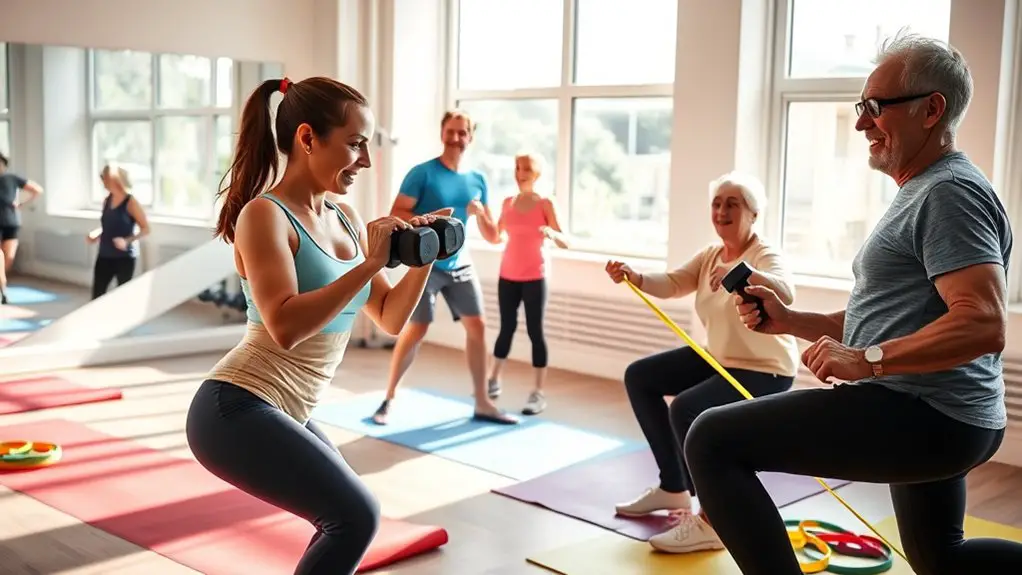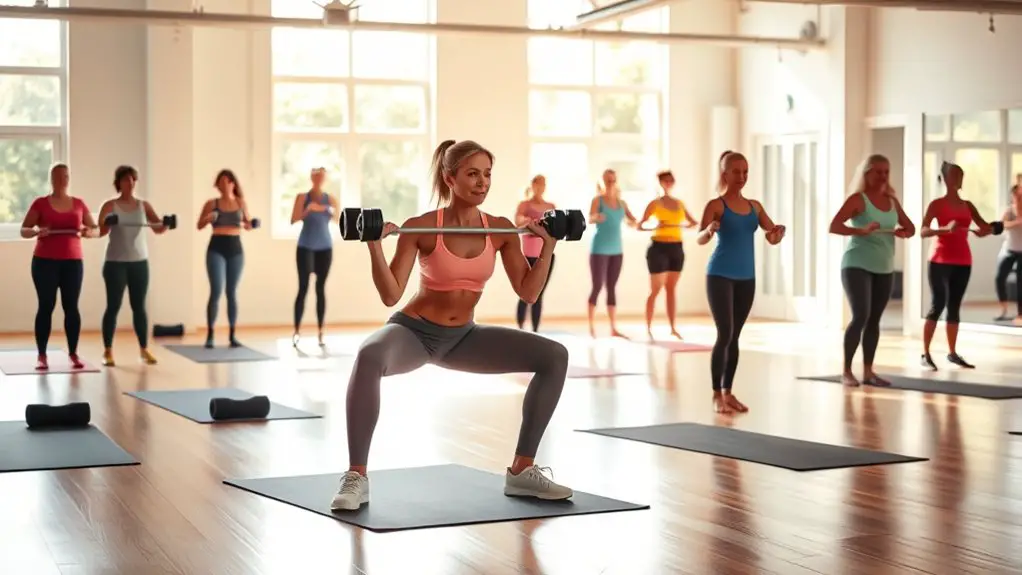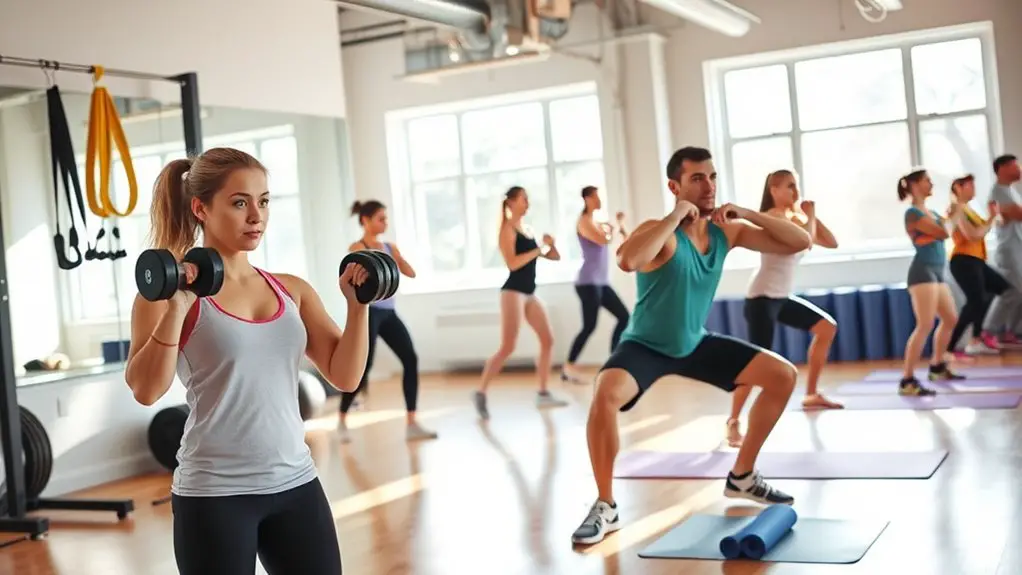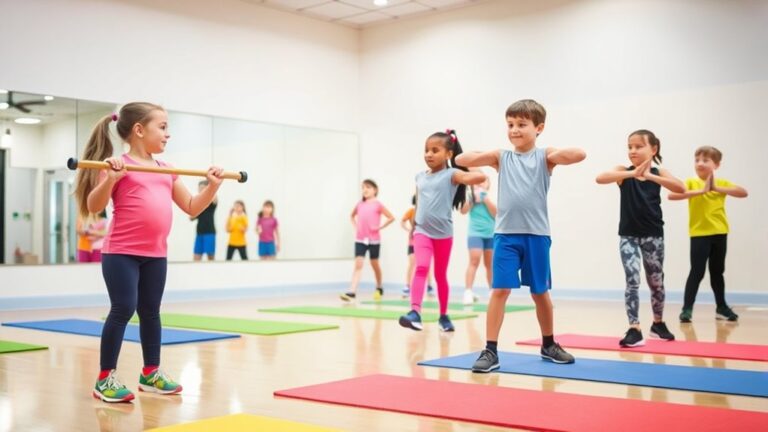The Best Gym Exercises for Bone Health and Osteoporosis Prevention

To boost bone health and prevent osteoporosis, focus on weight-bearing exercises like walking, jogging, or dancing, and integrate resistance training to build muscle and density. Aim for 30 minutes of activity several times a week. Don’t forget to include balance and flexibility exercises, as they help improve stability and reduce injury risks. Combining all these elements into a balanced routine can enhance your bone health. Discover more specific exercises that can help you further.
Understanding Osteoporosis and Bone Health

Understanding osteoporosis and bone health is important, especially since your bones are constantly changing throughout your life. Osteoporosis is a condition that weakens bones, making them fragile and more likely to break. It’s essential to recognize osteoporosis risk factors, like age, gender, family history, and lifestyle choices. If you’re a woman over 50 or have a family history of the disease, you should pay extra attention.
To support your bone health, focus on nutrition. A diet rich in calcium and vitamin D is important for maintaining strong bones. Incorporate dairy products, leafy greens, and fortified foods into your meals. Additionally, consider foods high in magnesium and phosphorus, as they play a role in bone density. Staying informed about these factors can help you proactively protect your bone health and reduce your risk of osteoporosis, ensuring your bones remain strong throughout your life.
Weight-Bearing Exercises for Stronger Bones
To build stronger bones, incorporating weight-bearing exercises into your routine is vital, especially as you age. These impactful activities help stimulate bone formation and can considerably reduce the risk of osteoporosis. Effective workouts include activities like walking, jogging, dancing, or even climbing stairs. They make your bones work against gravity, which is essential for maintaining bone density.
Start slowly and gradually increase your intensity to guarantee safety. Always listen to your body; if something feels uncomfortable, it’s important to stop. If you’re unsure where to begin, consider joining a class or working with a trainer who can guide you in performing exercises safely and effectively. Remember, consistency is key. Aim for at least 30 minutes of weight-bearing activities several times a week to reap the benefits. By committing to these exercises, you’re taking a proactive step towards better bone health and overall well-being.
Resistance Training: Building Muscle and Bone Density

While many people associate resistance training primarily with building muscle, it plays a crucial role in enhancing bone density too. When you lift weights, your muscles contract and create tension, which stimulates your bones to strengthen and grow. This process, known as muscle hypertrophy, is essential for maintaining strong bones, especially as you age.
To safely maximize your results, focus on progressive overload—gradually increasing the weight or resistance you’re using. This helps your muscles adapt and grow, while also reinforcing bone structure. Start with lighter weights and proper form to prevent injury. As you gain confidence and strength, you can slowly increase the intensity of your workouts.
Incorporating resistance training into your fitness routine not only helps you build muscle but also protects your bones, reducing the risk of osteoporosis. Additionally, skipping rope can further improve bone health by slowing density loss. Remember, consistency is key to achieving and maintaining these benefits over time.
The Role of Balance and Flexibility Exercises
Incorporating balance and flexibility exercises into your fitness routine is essential for maintaining bone health, especially as you age. These exercises help improve stability and coordination, reducing your risk of falls and fractures. You can easily integrate balance training and flexibility routines into your workouts to enhance your overall safety and well-being.
Incorporating balance and flexibility exercises into your routine is vital for bone health and reducing fall risk as you age.
Consider these benefits of balance and flexibility exercises:
- Enhances coordination and stability
- Improves posture and reduces muscle tension
- Increases range of motion and flexibility
- Strengthens supporting muscles around bones
- Lowers the risk of injury during daily activities
Creating a Balanced Workout Routine for Optimal Bone Health

Creating a balanced workout routine is vital for ideal bone health, as it combines strength training, cardiovascular exercise, and flexibility work. Start with strength training at least two to three times a week, focusing on weight-bearing exercises like squats and lunges to promote bone density. Don’t forget the cardio benefits; aim for 150 minutes of moderate aerobic activity weekly, such as brisk walking or cycling, to support overall health and circulation.
Incorporating flexibility exercises like yoga or stretching can enhance your range of motion, reducing injury risk. Remember, nutrition plays a significant role too. Make sure you’re getting enough calcium and vitamin D to support your bones. Pairing a well-rounded workout with a nutritious diet will maximize your efforts. Always consult a fitness professional or healthcare provider before starting a new routine, making certain it’s safe and tailored to your individual needs.
Frequently Asked Questions
Can Diet Impact Bone Health and Osteoporosis Risk?
Absolutely, your diet can greatly impact bone health and osteoporosis risk. Ensuring you get enough calcium sources, like dairy products and leafy greens, is essential for strong bones. Plus, vitamin D helps your body absorb calcium effectively, so consider foods rich in it, like fatty fish or fortified cereals. If you’re concerned about your bone health, focus on these nutrients to maintain safety and support your bones as you age.
How Often Should I Exercise for Optimal Bone Health?
To maintain ideal bone health, you should aim to exercise at least 150 minutes per week, spread over several days. This exercise frequency helps guarantee your bones get the stimulation they need. Consider incorporating weight-bearing and strength-training movements into your routines for maximum benefit. Always listen to your body and consult a healthcare professional before starting any new program, especially if you’re concerned about safety or have existing health conditions.
Are There Specific Exercises to Avoid With Osteoporosis?
When it comes to osteoporosis, think of your bones as delicate treasures; you’d wanna handle them with care. Avoid high-impact activities like running or jumping, as they can increase fracture risk. Instead, focus on balance training and low-impact exercises, which can help maintain strength without putting undue stress on your bones. Always consult your healthcare provider before starting a new workout routine to guarantee it’s safe for you. Stay cautious and keep moving!
What Age Should I Start Focusing on Bone Health?
You should start focusing on bone health as early as your twenties. Early intervention can make a significant difference, helping you establish lifelong habits that support strong bones. It’s never too late to prioritize your bone health, but the earlier you begin, the better. Incorporate weight-bearing exercises, a balanced diet rich in calcium and vitamin D, and regular check-ups to guarantee your bones remain strong and resilient throughout your life.
Can Supplements Improve Bone Density Alongside Exercise?
Imagine your bones as a sturdy bridge, and supplements as the nails that keep it intact. While exercise builds the framework, certain supplement types—like calcium and vitamin D—can enhance that foundation, creating a powerful exercise synergy. They’re not a magic fix, but they can support your efforts. Just remember, it’s essential to consult a healthcare professional before starting any supplements to guarantee safety and effectiveness in your bone health journey.





